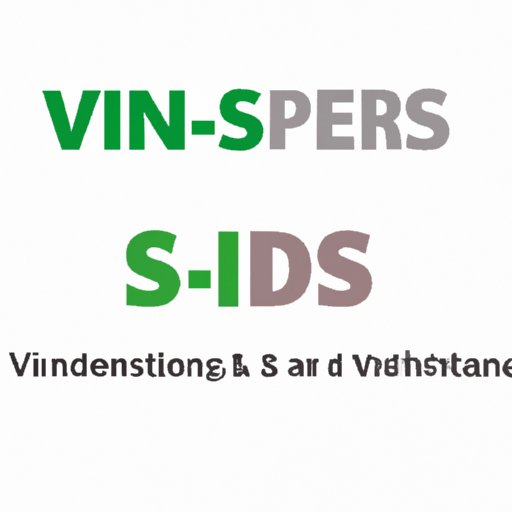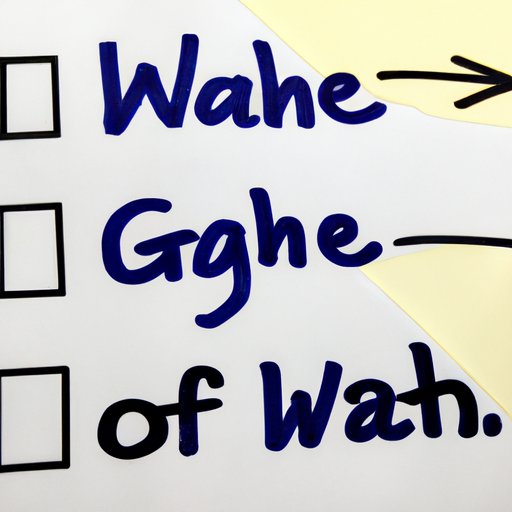I. Introduction
You’ve likely found yourself in a situation where you’re unsure of when to use ‘which’ or ‘that’ in a sentence. They are both words that are frequently used in the English language and can be easily confused. However, knowing the difference between the two is important for proper grammar and clear communication. In this ultimate guide, we will explore the distinctions between using ‘which’ and ‘that’ in your writing.
II. The Ultimate Guide to Understanding the Difference Between Which and That
‘Which’ and ‘that’ are both pronouns that refer to a previously mentioned noun. They are also known as relative pronouns, as they help to relate an idea or concept within the sentence. ‘Which’ is used to introduce non-essential clauses, while ‘that’ is used to introduce essential clauses.
Essential clauses are crucial to the meaning of the sentence and provide important information that cannot be left out. Without an essential clause, the sentence would be incomplete or make little sense. For example, “The car that I bought last week was stolen.” The essential clause here is “that I bought last week,” which specifies which car is being referred to and is necessary for the sentence’s meaning.
Non-essential clauses, on the other hand, provide additional information about the noun in question but could be omitted, and the sentence would remain grammatically complete and understandable. For example, “The car, which was blue, was stolen.” The non-essential clause here is “which was blue,” which adds color information but isn’t necessary for the sentence’s meaning.
III. Which vs That: How to Choose the Correct Word in Your Writing
Choosing between ‘which’ and ‘that’ can be challenging, but the differences between them are significant. Let’s examine some sentences to gain a further understanding of how they are used in a sentence:
– The book that I read last night was amazing.
– The book, which I read last night, was amazing.
In these examples, both ‘that’ and ‘which’ refer to the book, but they are used to introduce different types of clauses. In the first sentence, ‘that’ is used because the clause is essential to the sentence, and if it were removed, the sentence would lose its meaning. In contrast, the second sentence uses ‘which’ because the clause is non-essential and could be removed without losing the sentence’s meaning.
IV. Clearing Up the Confusion: Properly Using Which and That in Sentences
Despite their differences, many writers still find choosing between ‘which’ and ‘that’ confusing. To avoid confusion, some writers or editors may choose to remove ‘which’ and replace it with a comma instead. This is appropriate if the phrase is additional information and could be omitted without any change or loss of meaning. However, this could lead to the incorrect use of ‘that’ when it is necessary for sentence clarity and meaning.
Another common mistake is using ‘which’ instead of ‘that’ in essential clauses. This can be done inadvertently as non-native English speakers often use ‘which’ instead of ‘that’ for both essential and non-essential clauses in their language.
V. Mastering the Art of Choosing Between Which and That in Your Writing
Here are some exercises to practice using ‘which’ and ‘that’ in sentences and to get a better understanding of the distinction between the two:
- Choose the appropriate word in the following sentences:
- The book, which/that I am reading, is a best-seller.
- The dog, which/that belonged to my neighbor, bit me.
- The movie, which/that I watched last night, was very long.
- Identify the type of clause used in the following sentences:
- The pen that I lost last week was my favorite.
- The restaurant, which is located downtown, has great food.
- The car that I just bought is a hybrid.
Here are the correct answers:
-
- The book that
- The dog that
- The movie that
-
- Essential clause
- Non-essential clause
- Essential clause

VI. Understanding the Nuances of Which vs That: A Comprehensive Guide
Understanding the nuances between ‘which’ and ‘that’ is crucial for clear and concise communication. Here are some additional examples of complex sentence structures, and explanations of how to correctly choose between ‘which’ and ‘that’:
– Romans that were written long ago are still studied today for their literary merit.
– The rocket, which was launched yesterday, will land on the moon tomorrow.
In the first example, ‘that’ is used because the essential clause is “that were written long ago”, which provides an important aspect of the sentence’s meaning. In contrast, in the second example, ‘which’ is used because the clause is non-essential and provides an additional but not crucial aspect of the sentence.
VII. Which vs That: A Simple Rule to Follow for Correct Usage
The simplest way to choose between ‘which’ and ‘that’ is to remember the following rule: use ‘that’ for essential clauses and ‘which’ for non-essential clauses. Remembering this rule can help writers avoid common mistakes and ensure their writing is clear and easily understandable.
Here are a few additional contexts for when ‘that’ should be used:
- When ‘that’ helps distinguish a specific noun
- When ‘that’ is part of a set phrase or expression
- When ‘that’ is used after certain superlatives or similar words
VIII. Clarity in Writing: Knowing When to Use Which vs That
Clear communication is essential in any form of writing, whether it is creative writing or corporate communications. Using words like ‘which’ and ‘that’ correctly can make significant differences in how readers receive and comprehend your content. Now that you have a solid understanding of the differences between the two, you’ll be able to use them correctly and avoid common mistakes.
IX. Conclusion
This guide has provided you with a comprehensive understanding of when ‘which’ and ‘that’ should be used in your writing. Remember that ‘which’ is used for non-essential clauses, while ‘that’ is used for essential clauses. Utilize the exercises and tips given here to improve your writing skills and avoid confusion between the two words. With the right practice, you’ll be able to choose the appropriate word in your writing with greater ease and skill.
